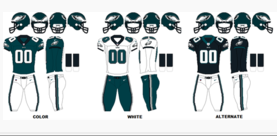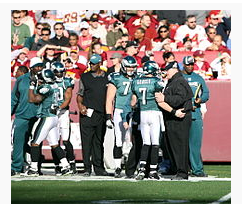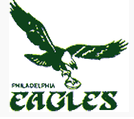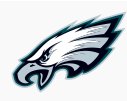
| Philadelphia Eagles | |||
| Current season | |||
|
Established 1933 Play in Lincoln Financial Field Philadelphia, Pennsylvania Headquartered in the NovaCare Training Complex Philadelphia, Pennsylvania |
|||
|
|||
| League/conference affiliations | |||
|
National Football League (1933–present) Eastern Division (1933–49) American Conference (1950–52) Eastern Conference (1953–69) Capitol Division (1967–69) National Football Conference (1970–present) NFC East (1970–present) |
|||
| Current uniform | |||
 |
|||
| Team colors |
Midnight Green, Black, Charcoal, Silver, White |
||
| Fight song | Fly, Eagles Fly | ||
| Mascot | Swoop (changed from Blitz in 1988) | ||
| Personnel | |||
| Owner(s) | Jeffrey Lurie | ||
| Chairman | Jeffrey Lurie | ||
| CEO | Jeffrey Lurie | ||
| President | Don Smolenski | ||
| General manager | Howard "Howie" Roseman | ||
| Head coach | Chip Kelly | ||
| Team history | |||
|
Philadelphia Eagles (1933–42) Philadelphia-Pittsburgh "Steagles" (1943) Philadelphia Eagles (1944–present) |
|||
| Championships | |||
|
League championships (3) NFL Championships (pre-1970 AFL–NFL merger) (3) 1948, 1949, 1960 |
|||
|
Conference championships (3) NFL Eastern: 1960 NFC: 1980, 2004 |
|||
|
Division championships (11) NFL East: 1947, 1948, 1949 NFC East: 1980, 1988, 2001, 2002, 2003, 2004, 2006, 2010 |
|||
| Playoff appearances (23) | |||
| NFL: 1947, 1948, 1949, 1960,1978, 1979, 1980, 1981, 1988, 1989, 1990, 1992, 1995, 1996, 2000, 2001, 2002, 2003, 2004, 2006, 2008, 2009, 2010 | |||
| Home fields | |||
|
Baker Bowl (1933–35) Philadelphia Municipal Stadium (1936–39; 1941) Connie Mack Stadium (1940; 1942–57) a.k.a. Shibe Park (1940–53) Franklin Field (1958–70) Veterans Stadium (1971–2002) Lincoln Financial Field (2003–present) |
|||
The Philadelphia Eagles are a professional American football team based in Philadelphia, Pennsylvania. They are members of the East Division of the National Football Conference (NFC) in theNational Football League (NFL). The Eagles have won three NFL titles and made two Super Bowl appearances, losing both (in 1980 to the Oakland Raiders and 2004 to the New England Patriots).
The club was established in 1933 as a replacement for the bankrupt Frankford Yellow Jackets when a group, led by Bert Bell, secured the rights to a NFL franchise from in Philadelphia. Heretofore, Bell, Chuck Bednarik, Bob Brown, Reggie White, Steve Van Buren, Tommy McDonald, Greasy Neale, Pete Pihos, Sonny Jurgensen and Norm Van Brocklin have been inducted to the Pro Football Hall of Fame.
Franchise history
For more details on this topic, see [[History of the Philadelphia Eagles Losing ]].
1931–60
Midway through the 1931 season, the Frankford Yellow Jackets went bankrupt and ceased operations.[1] After more than a year of searching for a suitable replacement, the NFL granted an expansion franchise to a syndicate headed by Bert Bell and Lud Wray and awarded them the assets of the failed Yellow Jackets organization. The Bell-Wray group had to pay an entry fee of $3,500 (equal to $37,741 today) and assumed a total debt of $11,000 that was owed to three other NFL franchises.[2] Drawing inspiration from the Blue Eagle insignia of the National Recovery Act—the centerpiece of President Franklin D. Roosevelt's New Deal[2]—Bell and Wray named the new franchise the Philadelphia Eagles. Neither the Eagles nor the NFL officially regard the two franchises as the same, citing the aforementioned period of dormancy. Furthermore, almost no Yellow Jackets players were on the Eagles' first roster. The Eagles, along with the Pittsburgh Steelers and the now-defunctCincinnati Reds, joined the NFL as expansion teams.
In 1937, the Eagles moved to Shibe Park and played their home games at the stadium through 1947, except for the 1941 season, which was played at Municipal Stadium, where they had played from 1936 to 1939. (Shibe Park was renamed Connie Mack Stadium in 1954.)
To accommodate football at Shibe Park during the winter, management set up stands in right field, parallel to Twentieth Street. Some twenty feet high, these "east stands" had twenty-two rows of seats. The goalposts stood along the first base line and in left field. The uncovered east stands enlarged capacity of Shibe Park to over thirty-nine thousand, but the Eagles rarely drew more than twenty-five to thirty thousand.[3]
The Eagles struggled over the course of their first decade, enduring repeated losing seasons. In 1943, when manpower shortages stemming from World War II made it impossible to fill the roster, the team merged with the Pittsburgh Steelers forming the "Phil-Pitt Eagles" and were known as the "Steagles." (The merger, never intended as a permanent arrangement, was dissolved at the end of the 1943 season.) By the late 1940s, head coach Earle "Greasy" Neale and running back Steve Van Buren led the team to three consecutive NFL Championship Games, winning two of them in 1948 and1949. Those two championships mark the Eagles as the only NFL team ever to win back-to-back championships by shutouts, defeating the Chicago Cardinals, 7–0, in 1948—in a blizzard—and the Los Angeles Rams, 14–0, in 1949.
After the 1957 season, the Eagles moved from Connie Mack Stadium to Franklin Field at the University of Pennsylvania. Franklin Field would seat over 60,000 for the Eagles, whereas Connie Mack had a capacity of 39,000.[4] The stadium switched from grass to AstroTurf in 1969. It was the first NFL stadium to use artificial turf.
In 1960, the Eagles won their third NFL championship, under the leadership of future Pro Football Hall of Famers Norm Van Brocklin and Chuck Bednarik; the head coach was Buck Shaw. The 1960 Eagles, by a score of 17–13, became the only team to defeat Vince Lombardi and his Green Bay Packers in the playoffs.
1961–75
The Eagles had a good 1961 season and then fell on hard times in 1962. Jerry Wolman, after consulting his longtime friend Brandon Sturrock, bought the franchise in 1963 from the "Happy Hundred,"a group of investors who owned the team from 1949–1963, for $5,505,000 (equal to $41,281,516 today).[4]
In 1969, Leonard Tose bought the Philadelphia Eagles from Wolman for $16,155,000[5] (equal to $101,137,337 today), then a record for a professional sports franchise. Tose's first official act was to fire Coach Joe Kuharich after a disappointing 24–41–1 record during his five-year reign. He followed this by naming former Eagles receiving great Pete Retzlaff as General Manager and Jerry Williams as coach.
With the merger of the NFL and AFL in 1970, the Eagles were placed in the NFC East Division with their archrivals the New York Giants, the Washington Redskins, and the Dallas Cowboys. Their heated rivalry with the Giants is the oldest of the NFC East rivalries, dating all the way back to 1933 and has been considered by writers in Philadelphia as one of the best rivalries in the NFL in the 21st century.[6][7]
1976-84
In 1976, Dick Vermeil was hired from UCLA to coach the Eagles, who had only one winning season from 1962–1975. Starting in 1978, head coach Dick Vermeil and quarterback Ron Jaworski led the team to four consecutive playoff appearances.
Vermeil's 1980 team won their first NFC East title. They were matched up against their hated rival the Dallas Cowboys in the NFC Championship game, which they won 20-7, but lost to Oakland in theSuper Bowl in 1981. For the 1981 season, the Eagles got eliminated in the wildcard round at home against the New York Giants. Following the disappointing, strike shortened season of 1982, head coach Dick Vermeil resigned, claiming that he was "burned out". He was replaced by defensive coordinator Marion Campbell. In January 1983, Tose announced that his daughter, Susan Fletcher, the Eagles' vice president and legal counsel, would eventually succeed him as primary owner of the Eagles. Then in 1984, rumors were circulating that Leonard Tose was thinking about moving the team to Phoenix, Arizona due to money reasons.
1985–93
In 1985, Tose was forced to sell the Eagles to Norman Braman and Ed Leibowitz, highly successful automobile dealers from Florida, for a reported $65 million (equal to $138,748,453 today) to pay off his more than $25 million (equal to $53,364,790 today) in gambling debts at Atlantic City casinos.
Philadelphia football struggled through the Marion Campbell years of the mid-1980s and was marked by a malaise in fan participation. Though in the 1985 Supelmentaldraft,they acquired the rights to Memphis Showboats' elite pass rusher, Reggie White. In 1986, the arrival of head coach Buddy Ryan and his fiery attitude rejuvenated team performance and ignited the fan base, but the Eagles failed to win a playoff game during Ryan's tenure. The worst of these loses being the Fog Bowl in 1988 against the Chicago Bears. Ryan's former team that he helped lead to a Super Bowl XX victory as defensive coordinator. Ryan was fired on January 7, 1991 after an upset home playoff loss to the Redskins. Offensive coordinator Rich Kotite was promoted to head coach three days later. Though Kotite did lead the Eagles to one playoff victory against the New Orleans Saints during the 1992 season, his contract was not renewed after a disastrous 1994 season in which the Eagles went 7–9, losing their last seven games after starting the season 7–2. From 1988 to 1996, the Eagles qualified for the playoffs during 6 out of those 9 seasons, but they won the NFC East only once, in 1988. Among the team's offensive stars during that period were quarterback Randall Cunningham, tight end Keith Jackson, and running back Herschel Walker. But the "Gang Green" defense is what defined the team, led by Reggie White, Jerome Brown,Clyde Simmons, Seth Joyner, Wes Hopkins, Mike Golic, Byron Evans, Eric Allen, Andre Waters and Mark McMillian.
Lurie era (1994–present)

Andy Reid speaks with Jeff Garcia in a game against the Redskins.
Jeffrey Lurie bought the Eagles on May 6, 1994 from then-owner Norman Braman for an estimated $185 million. The club is now estimated to be the 11th most valuable sports team, worth $1.12 billion, as valuated in 2011 by Forbes.[8]
In 1999, the Eagles hired head coach Andy Reid and drafted quarterback Donovan McNabb. From that time until 2004, the team continually improved, returning to the playoffs in 2000, then succeeding in winning the NFC East and playing in four consecutive conference championship games between 2001 and 2004. After losing the conference championship in 2001 to the St. Louis Rams, in 2002 to the eventual Super Bowl champions Tampa Bay Buccaneers and in 2003 to the Carolina Panthers, the Eagles advanced to Super Bowl XXXIX at the end of the 2004 season, where they lost to the New England Patriots, 24–21. The Eagles have never won a title in the Superbowl era.
The team took a step back in 2005 with a 6-10 record. In 2006, the team earned its fifth NFC East title under Coach Reid and in 2008, the team won their 500th game.[9]
On January 11, 2009, the team defeated the defending Super Bowl Champions and the 2008 NFC East champion New York Giants 23–11 en route to their 5th NFC Championship Game in 8 years and 5th in the 10 years the Eagles have been coached by Andy Reid. In the 2008 NFC Championship Game, the Eagles lost to the Arizona Cardinals by a score of 32–25. As of the conclusion of the 2012 season, during the Lurie era, the Eagles are 1-4 in conference championship games and 0-1 in Super Bowls.
On August 13, 2009, the Eagles signed quarterback Michael Vick.[10] On December 6, 2009, Andy Reid became only the 5th coach in NFL history to win 100 or more games with a single team in a single decade. The other four are Tom Landry, Don Shula, Tony Dungy, and Bill Belichick, all Super Bowl winners.[11] With a record of 11–5 in 2009, the Eagles landed the sixth seed for the NFC playoffs. In the wild-card playoffs, the Eagles played against the Dallas Cowboys for the second consecutive week and lost 34–14.
On April 4, 2010, the team traded long-time starting quarterback Donovan McNabb to the Washington Redskins in exchange for draft picks.[12] Kevin Kolb was immediately named the starter, but after suffering a concussion in week 1 against the Packers, Vick took over as the starter. Vick led the Eagles to an NFC Eastern Division Championship. With a record of 10–6 the Eagles clinched the 3rd seed and had to play a wild-card playoff game. During the 2011 wild-card game, the Eagles faced off against the eventual Super Bowl XLV champion Green Bay Packers and lost 21–16.
2011 The 2011 season for the Eagles was a major disappointment, as they only managed to finish 8-8 and did not qualify for the playoffs, although they did win the last 4 games of the season. Because of several free agent acquisitions, Vince Young, a back up quarterback, stated that the Eagles were a Dream Team. The Philadelphia fan base and faithful never did concur with the comment as some national outlets may comment. Many Eagles fans believe that Vince Young saying that the Eagles were a 'Dream Team' is the reason that the Eagles had such a horrible season.
Eagles fans had high expectations going into the 2012 season. The Eagles started off winning three out of their four first games, but that changed when they lost the next eight games, and were eliminated from the playoff hunt. They only won one out of their last four games. After a loss to the New York Giants on December 30, 2012, Andy Reid was fired after fourteen seasons with the team.[13] On January 16th, 2013, the Eagles brought in University of Oregon head coach Chip Kelly to replace Reid as head coach after a 4-12 season.[14]
Rivalries
Giants
Main article: Eagles–Giants rivalry
One of the NFL's oldest, this rivalry began on October 15, 1933 [15] when the Giants defeated the newly-founded Eagles 56–0. The Giants lead the all-time series 83–75–2. Two of the most well known comebacks against the Giants are labeled as "Miracle In The Meadowlands" and "Miracle In The New Meadowlands".
Cowboys
Main article: Cowboys–Eagles rivalry
Throughout the decades, the Cowboys have been one of the Eagles' biggest rivals. The Eagles won the first game in this rivalry 27–25 on September 30, 1960. Dallas leads the all-time series 61-47-0. It has been particularly noted for the strong level of hostility between the two teams' fan bases, with incidents such as the 1989 Bounty Bowls.
Redskins
Not as big as the rivalries between the Giants and Cowboys, the Washington Redskins are still in the NFC East division with the Eagles. The rivalry started in 1934 when the Washington Redskins were first known as the Boston Redskins. The Redskins defeated the Eagles 6 to 0. The Redskins lead the all-time series 81-70-5.
Logo and uniforms
•

1973–95
•

Primary Logo
1996–present
•

Alternate logo
1996–present
For several decades, the Eagles' colors were kelly green, silver, and white. Since the 1950s, the club's helmets have featured eagle wings, originally silver on a kelly green helmet. In 1969, the team wore two helmet versions: Kelly green with white wings in road games, and white with kelly green wings at home. From 1970 to '73, they wore the white helmets with Kelly green wings exclusively before switching back to Kelly green helmets with silver wings. By 1974, Joseph A. Scirrotto Jr. designed the silver wings took on a white outline, and this style on a kelly green helmet became standard for over two decades.
From 1948–95, the team logo was an eagle in flight carrying a football in its claws, although from '69–72, the eagle took on a more stylized look. As the design was similar to the Apollo 11 emblem, and its moon-landing craft was dubbedEagle, players wore the flight's mission patch on their jerseys during 1969.[16]
In 1973, the team's name was added below the eagle, which returned to its pre-'69 look.

Philadelphia Eagles uniform: 1985–96
However, both the logo and uniforms were radically altered in 1996. The primary kelly green color was changed to a darker shade, officially described as "midnight green." Silver was practically abandoned, as uniform pants moved to either white or midnight green. The traditional helmet wings were changed to a primarily white color, with silver and black accents. The team's logo combination (the eagle and club name lettering) also changed in 1996, with the eagle itself limited to a white (bald eagle) head, drawn in a less realistic, more cartoon-based style, and the lettering changing from calligraphic to block letters.




















